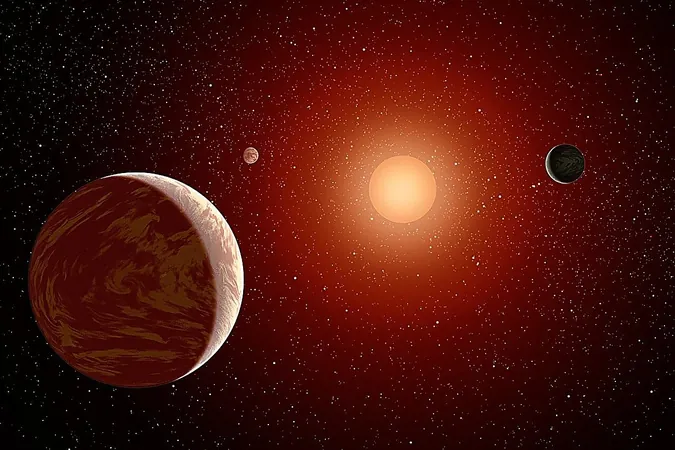
Revolutionary Exoplanet Discovery in a Binary System May Unlock Secrets of Planet Formation Around Red Dwarfs!
2024-10-11
Author: Liam
Exciting Breakthrough in Exoplanet Research
In an exciting breakthrough for astronomers, the hunt for extrasolar planets, or exoplanets, has reached new heights with a staggering total of 5,799 confirmed planets within 4,310 star systems. As many more candidates await verification, the intriguing patterns surrounding M-type stars, or red dwarfs, have grabbed the scientific community's attention. These cooler stars seem particularly adept at forming rocky planets and even gas giants, often raising questions about the very processes driving planet formation.
Study of the TOI-6383 System
A recent study focused on the fascinating TOI-6383 system, which consists of two red dwarf stars located approximately 560 light-years away from Earth. At the helm of this study was a dynamic international team from the Searching for Giant Exoplanets around M-dwarf Stars (GEMS) survey. Their key discovery? A giant planet designated TOI-6383Ab, which remarkably rivals the size and mass of its companion star, TOI-6383A.
Key Contributors
Lia Marta Bernabò, a Ph.D. astronomy student at the University of Texas at Austin, led this groundbreaking research. Her collaboration included esteemed scientists from the German Aerospace Center and various top institutions such as the Carnegie Science Earth and Planets Laboratory, the ETH Zurich Institute for Particle Physics & Astrophysics, and NASA's Goddard Space Flight Center. Their findings have been accepted for publication in the Astronomical Journal, making waves in the scientific community.
Characteristics of the Stars
TOI-6383A boasts around 46% of the Sun's mass and a surface temperature of approximately 3,444 K. In contrast, the second star, TOI-6383B, is even smaller, at only 20.5% of the Sun’s mass. Among this cosmic duo, the newly detected planet, TOI-6383Ab, orbits with a remarkably short period of just 1.79 days, reminiscent of Jupiter but in a far more extreme environment.
Implications for Planet Formation Theories
This discovery poses challenging questions regarding the formation of massive planets around such low-mass stars. Traditionally, two primary theories for planetary formation exist: the core-accretion model, which has seen skepticism in recent years, and the rapid formation model, which suggests planets can form quickly from massive disks of gas and dust. The existence of TOI-6383Ab could provide crucial data to test these theories and understand the mechanisms behind planet formation amidst the peculiarities of red dwarf systems.
Future of Exoplanet Research
Historically, only 20 massive exoplanets have been identified orbiting M-type stars, making the GEMS project's aim to surpass this number to at least 40 a crucial step for solar system evolution studies. These insights could lead to revolutionary understandings of how our own solar system formed and might hold the key to discovering new worlds capable of harboring life.
Conclusion and Future Updates
Stay tuned for more updates on this groundbreaking discovery, as astronomers are only just beginning to unravel the secrets held by these distant celestial bodies!









 Brasil (PT)
Brasil (PT)
 Canada (EN)
Canada (EN)
 Chile (ES)
Chile (ES)
 España (ES)
España (ES)
 France (FR)
France (FR)
 Hong Kong (EN)
Hong Kong (EN)
 Italia (IT)
Italia (IT)
 日本 (JA)
日本 (JA)
 Magyarország (HU)
Magyarország (HU)
 Norge (NO)
Norge (NO)
 Polska (PL)
Polska (PL)
 Schweiz (DE)
Schweiz (DE)
 Singapore (EN)
Singapore (EN)
 Sverige (SV)
Sverige (SV)
 Suomi (FI)
Suomi (FI)
 Türkiye (TR)
Türkiye (TR)